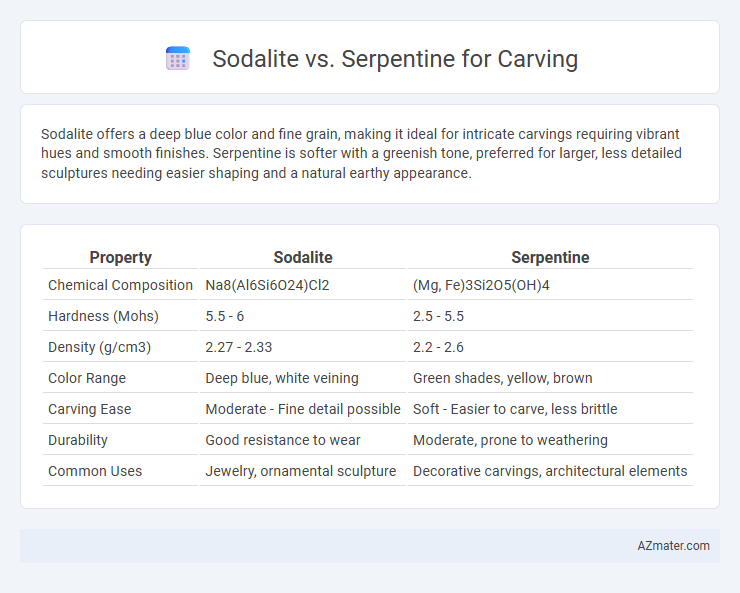Sodalite offers a deep blue color and fine grain, making it ideal for intricate carvings requiring vibrant hues and smooth finishes. Serpentine is softer with a greenish tone, preferred for larger, less detailed sculptures needing easier shaping and a natural earthy appearance.
Table of Comparison
| Property | Sodalite | Serpentine |
|---|---|---|
| Chemical Composition | Na8(Al6Si6O24)Cl2 | (Mg, Fe)3Si2O5(OH)4 |
| Hardness (Mohs) | 5.5 - 6 | 2.5 - 5.5 |
| Density (g/cm3) | 2.27 - 2.33 | 2.2 - 2.6 |
| Color Range | Deep blue, white veining | Green shades, yellow, brown |
| Carving Ease | Moderate - Fine detail possible | Soft - Easier to carve, less brittle |
| Durability | Good resistance to wear | Moderate, prone to weathering |
| Common Uses | Jewelry, ornamental sculpture | Decorative carvings, architectural elements |
Introduction to Sodalite and Serpentine
Sodalite is a rich royal blue mineral composed mainly of sodium, aluminum, silicon, oxygen, and chlorine, prized for its vibrant color and ease of carving in sculpture and jewelry. Serpentine, a group of green to yellow-green minerals formed from magnesium silicate, offers a softer texture ideal for detailed carving and ornamental objects. Both stones vary in hardness and texture, impacting their suitability for different artistic carving techniques and finished piece durability.
Geological Origins of Sodalite and Serpentine
Sodalite originates from igneous rocks, primarily forming in silica-poor environments such as nepheline syenites and related pegmatites, characterized by its rich sodium aluminum silicate composition. Serpentine, however, is a metamorphic mineral derived from the alteration of ultramafic rocks, particularly peridotites, through hydrothermal processes rich in magnesium silicate. These distinct geological origins influence their physical properties and suitability for carving, with sodalite offering a denser, more uniform texture and serpentine exhibiting variable softness and fibrous structures.
Physical Properties Comparison
Sodalite features a hardness of 5.5-6 on the Mohs scale, making it moderately durable and suitable for detailed carving, while Serpentine is softer with a hardness of 2.5-5, allowing easier shaping but increased susceptibility to scratches and damage. Sodalite exhibits a vitreous to greasy luster and a dense, crystalline structure, offering a solid, stable carving medium, whereas Serpentine has a waxy to silky luster with a more fibrous texture that can influence intricate design precision. The color range of Sodalite typically includes deep blues with white veining, enhancing aesthetic appeal, compared to Serpentine's green hues that can vary widely in tone, affecting visual texture in carvings.
Color and Visual Appeal
Sodalite offers vibrant royal blue hues with striking white veining, making it a visually captivating choice for carving projects seeking bold color contrasts. Serpentine typically displays a rich range of green shades, from deep olive to bright lime, often accompanied by smooth, waxy textures that enhance its natural appeal. The choice between sodalite and serpentine depends on whether a carving emphasizes cool, dramatic blues or earthy, organic greens for maximum aesthetic impact.
Workability for Carving
Sodalite offers moderate workability for carving due to its relatively soft Mohs hardness of 5.5 to 6, allowing artisans to achieve detailed designs with appropriate tools. Serpentine, softer with a Mohs hardness ranging from 2.5 to 5, is generally easier to carve and shape, making it ideal for intricate and delicate sculptures. The slightly higher hardness of sardolite requires sharper tools and more effort, whereas serpentine permits smoother finishes and faster carving processes.
Durability and Longevity
Sodalite offers moderate durability with a Mohs hardness of around 5.5 to 6, making it suitable for intricate carvings that maintain detail over time. Serpentine, softer at approximately 3 to 5 on the Mohs scale, is easier to carve but less resistant to scratches and weathering, reducing its longevity in outdoor or high-wear environments. For projects requiring lasting durability and preservation of fine details, sodalite is the preferred choice over serpentine.
Popular Uses in Art and Jewelry
Sodalite is prized for its rich royal blue color with white veining, making it a popular choice for detailed carvings, beads, and ornamental jewelry often used in necklaces and bracelets. Serpentine, known for its smooth, green to yellow-green hues, is favored for larger sculptures and cabochons in jewelry due to its softer texture and easy workability. Both stones are valued in art and jewelry for their distinct aesthetics, with sodalite preferred for vivid color contrasts and serpentine for its earthy, natural appeal.
Price and Availability
Sodalite is generally more expensive than serpentine due to its vibrant blue coloration and limited deposits, making it less widely available. Serpentine is more affordable and commonly found in large quantities, favored by carvers for its softness and ease of workability. Both stones are popular for carving, but serpentine's lower price and greater availability make it the preferred choice for budget-conscious artists.
Maintenance and Care Tips
Sodalite requires gentle cleaning with a soft cloth and mild soap to maintain its deep blue color, avoiding prolonged water exposure to prevent damage. Serpentine is softer and more porous, demanding careful handling, regular dusting, and avoidance of acidic or abrasive cleaners to preserve its green hues and intricate patterns. Both stones benefit from occasional waxing to enhance luster and provide a protective layer against scratches and environmental wear.
Choosing the Right Stone for Your Carving Project
Sodalite offers a vibrant blue hue with excellent hardness around 5.5 to 6 on the Mohs scale, making it ideal for detailed carvings that require durability and fine finishes. Serpentine, softer at about 2.5 to 5.5 on the Mohs scale, provides a range of green shades and is easier to carve but less suitable for intricate work or items exposed to wear. Choosing the right stone depends on the desired color, hardness for carving precision, and the project's exposure to handling or environmental wear.

Infographic: Sodalite vs Serpentine for Carving
 azmater.com
azmater.com